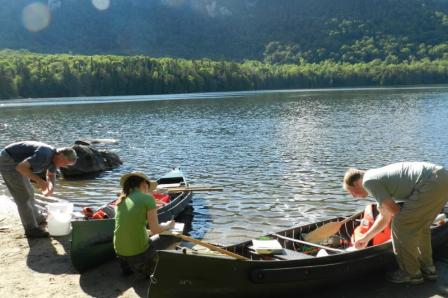Measuring Ecosystem Health: 50 Years of Science to Protect America’s Ecosystems
 In the summer of 2012, 89 National Lake Assessment field crews sampled 1,038 U.S. lakes using consistent methods and following standardized quality assurance protocols. Published August 4, 2020
In the summer of 2012, 89 National Lake Assessment field crews sampled 1,038 U.S. lakes using consistent methods and following standardized quality assurance protocols. Published August 4, 2020
This year marks EPA’s 50th anniversary, giving us an opportunity to highlight how our science has played a critical role in helping the Agency meet its mission to safeguard public health and the environment.
Two years after EPA was established in 1970, the Clean Water Act was written into law and required states to report to EPA on the condition of their waters. These reports were summarized by EPA and sent to Congress. However, approaches to collecting and evaluating data over the years would vary from state to state, making it difficult to compare the information across states, on a nationwide basis, or over time.
In 1987, Rick Linthurst, the research lead for the effort, began to wonder if there was a better way to monitor the environment than chasing one problem at a time. Couldn’t we track the “health” of ecosystems rather than just each new problem as it arose? Rick and his EPA colleagues Jay Messer, Scott Overton, Fred Holland, and Kevin Summers assessed the potential for a national probabilistic monitoring program. Two additional researchers joined the discussions, Tony Olsen and Steve Paulsen, and by 1989, the skeleton of the new program was designed.
The Environmental Monitoring and Assessment Program (EMAP) began as a research program to develop the tools necessary to monitor and assess the status and trends of national ecological resources. EMAP collected field data from 1990 to 2006 looking at the conditions of aquatic ecosystems, how they were changing over time, and the major stresses impacting them.
EPA scientist and freshwater ecologist Steve Paulsen explained the importance of EMAP’s survey design.
“In developing EMAP, we focused on an approach toward indicators that were consistent with the goal of the Clean Water Act – to restore and maintain the chemical, physical, and biological integrity of the Nation’s waters. In addition, the EMAP sampling process was based on a probabilistic design, which differed from how the states were sampling at the time but allowed for a rigorous assessment of all waters based on a statistically representative set of sampling sites. This provided more statistical power in the assessments with a lower number of stations and therefore lower cost.”
The research that went into EMAP eventually helped form the technical foundation for the National Aquatic Resource Surveys (NARS). The NARS began in the early 2000s as a collaboration between EPA, states, and tribes to provide the public and decision-makers with improved environmental information on the quality of the nation's coastal waters, lakes and reservoirs, rivers and streams, and wetlands.
The NARS is a series of surveys designed for consistency and comparability that provide critical data on the nation's waters. It’s also how the nation’s aquatic resources are now routinely monitored. NARS is helping to build stronger water quality monitoring programs across the country by fostering collaboration on new methods, indicators and research.
The Wadeable Streams Assessment (WSA), published in 2006, was the first NARS report, and the first national, consistently implemented, and statistically representative study of the nation’s wadeable streams. At the same time, EPA was conducting the National Coastal Condition Assessment based on data from estuaries across the country. These efforts were followed by the first National Lakes Assessment (NLA 2007). The current NARS are made up of four individual surveys that are implemented on a rotating basis: The National Coastal Condition Assessment, The National Lakes Assessment, The National Rivers and Streams Assessment, and The National Wetland Condition Assessment.
While EPA’s Office of Water (OW) manages the NARS, scientists in EPA’s Office of Research and Development (ORD) continue to be heavily involved in the surveys by providing critical technical support and research throughout the process and developing useful applications of the data.
“The NARS is designed to measure our progress toward protecting and restoring the quality of the nation’s waters,” says Dr. Paulsen, who continues to be involved in NARS as the ORD liaison to OW. “The thing that keeps the entire ORD team going is knowing that we can make a difference.”
Learn More
